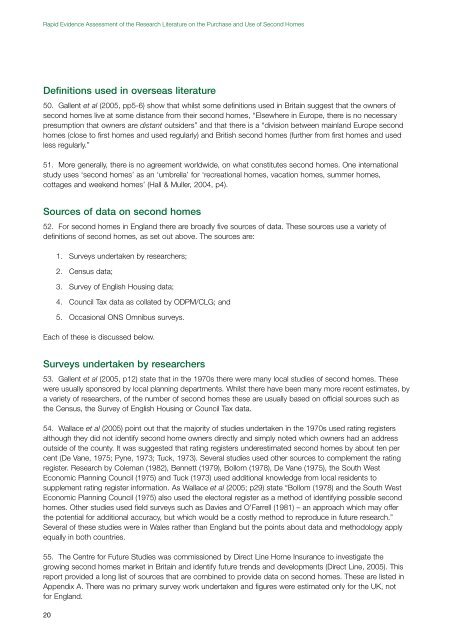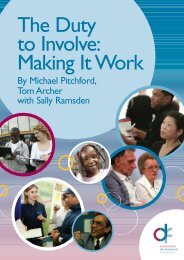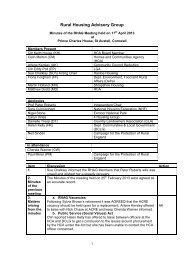Rapid Evidence Assessment of the Research ... - Rural Housing
Rapid Evidence Assessment of the Research ... - Rural Housing
Rapid Evidence Assessment of the Research ... - Rural Housing
Create successful ePaper yourself
Turn your PDF publications into a flip-book with our unique Google optimized e-Paper software.
<strong>Rapid</strong> <strong>Evidence</strong> <strong>Assessment</strong> <strong>of</strong> <strong>the</strong> <strong>Research</strong> Literature on <strong>the</strong> Purchase and Use <strong>of</strong> Second Homes<br />
Definitions used in overseas literature<br />
50. Gallent et al (2005, pp5-6) show that whilst some definitions used in Britain suggest that <strong>the</strong> owners <strong>of</strong><br />
second homes live at some distance from <strong>the</strong>ir second homes, “Elsewhere in Europe, <strong>the</strong>re is no necessary<br />
presumption that owners are distant outsiders” and that <strong>the</strong>re is a “division between mainland Europe second<br />
homes (close to first homes and used regularly) and British second homes (fur<strong>the</strong>r from first homes and used<br />
less regularly.”<br />
51. More generally, <strong>the</strong>re is no agreement worldwide, on what constitutes second homes. One international<br />
study uses ‘second homes’ as an ‘umbrella’ for ‘recreational homes, vacation homes, summer homes,<br />
cottages and weekend homes’ (Hall & Muller, 2004, p4).<br />
Sources <strong>of</strong> data on second homes<br />
52. For second homes in England <strong>the</strong>re are broadly five sources <strong>of</strong> data. These sources use a variety <strong>of</strong><br />
definitions <strong>of</strong> second homes, as set out above. The sources are:<br />
20<br />
1. Surveys undertaken by researchers;<br />
2. Census data;<br />
3. Survey <strong>of</strong> English <strong>Housing</strong> data;<br />
4. Council Tax data as collated by ODPM/CLG; and<br />
5. Occasional ONS Omnibus surveys.<br />
Each <strong>of</strong> <strong>the</strong>se is discussed below.<br />
Surveys undertaken by researchers<br />
53. Gallent et al (2005, p12) state that in <strong>the</strong> 1970s <strong>the</strong>re were many local studies <strong>of</strong> second homes. These<br />
were usually sponsored by local planning departments. Whilst <strong>the</strong>re have been many more recent estimates, by<br />
a variety <strong>of</strong> researchers, <strong>of</strong> <strong>the</strong> number <strong>of</strong> second homes <strong>the</strong>se are usually based on <strong>of</strong>ficial sources such as<br />
<strong>the</strong> Census, <strong>the</strong> Survey <strong>of</strong> English <strong>Housing</strong> or Council Tax data.<br />
54. Wallace et al (2005) point out that <strong>the</strong> majority <strong>of</strong> studies undertaken in <strong>the</strong> 1970s used rating registers<br />
although <strong>the</strong>y did not identify second home owners directly and simply noted which owners had an address<br />
outside <strong>of</strong> <strong>the</strong> county. It was suggested that rating registers underestimated second homes by about ten per<br />
cent (De Vane, 1975; Pyne, 1973; Tuck, 1973). Several studies used o<strong>the</strong>r sources to complement <strong>the</strong> rating<br />
register. <strong>Research</strong> by Coleman (1982), Bennett (1979), Bollom (1978), De Vane (1975), <strong>the</strong> South West<br />
Economic Planning Council (1975) and Tuck (1973) used additional knowledge from local residents to<br />
supplement rating register information. As Wallace et al (2005; p29) state “Bollom (1978) and <strong>the</strong> South West<br />
Economic Planning Council (1975) also used <strong>the</strong> electoral register as a method <strong>of</strong> identifying possible second<br />
homes. O<strong>the</strong>r studies used field surveys such as Davies and O’Farrell (1981) – an approach which may <strong>of</strong>fer<br />
<strong>the</strong> potential for additional accuracy, but which would be a costly method to reproduce in future research.”<br />
Several <strong>of</strong> <strong>the</strong>se studies were in Wales ra<strong>the</strong>r than England but <strong>the</strong> points about data and methodology apply<br />
equally in both countries.<br />
55. The Centre for Future Studies was commissioned by Direct Line Home Insurance to investigate <strong>the</strong><br />
growing second homes market in Britain and identify future trends and developments (Direct Line, 2005). This<br />
report provided a long list <strong>of</strong> sources that are combined to provide data on second homes. These are listed in<br />
Appendix A. There was no primary survey work undertaken and figures were estimated only for <strong>the</strong> UK, not<br />
for England.






